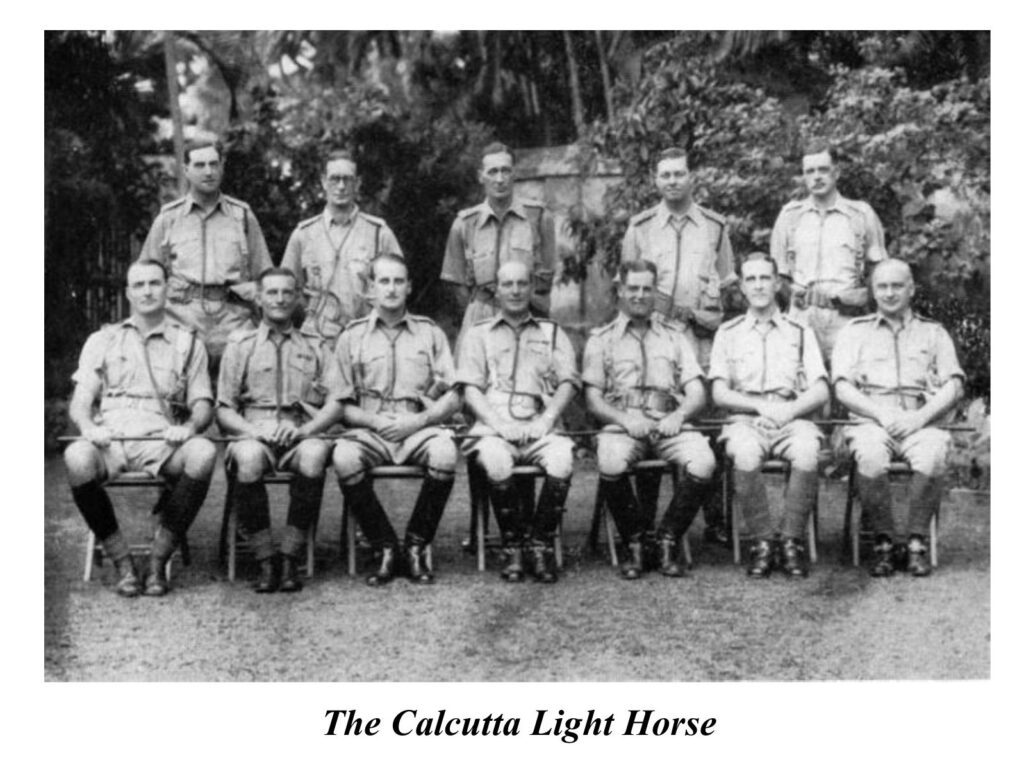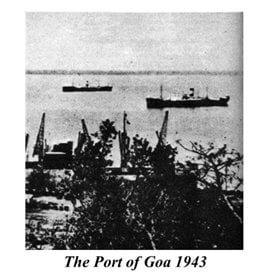
Do you think Dad’s Army only defended Blighty?
Think again.
Unbelievably, a group of middle-aged bankers, lawyers, and ex-officers from the Calcutta Light Horse launched a daring covert mission in 1943 Goa, sinking a Nazi radio ship and outwitting German U-boats—all without official recognition. The truth is stranger than fiction.
Let me tell you about Operation Creek, it was carried out by the members of the Calcutta Light Horse in Goa in 1943. Have you heard of it?
It all goes back to the Calcutta Light Horse which was formed in 1872 as a part of the Cavalry Reserve of the British Indian Army. By 1943 it had become a drinking club for the older officers, and they really weren’t seeing any action.
What Started it?
As I am sure you know in 1943 Britain was at war, India was part of our Empire, but the small port, Goa, on the East side of India was in the Portuguese Empire!
This became a problem.
The Port of Goa
 Now, it appears that at the time there had been three German merchant ships sitting in the Port of Goa since the outbreak of the war in 1939. It was assumed that they were there as Portugal was neutral during the war while, of course, the British territory of India was not.
Now, it appears that at the time there had been three German merchant ships sitting in the Port of Goa since the outbreak of the war in 1939. It was assumed that they were there as Portugal was neutral during the war while, of course, the British territory of India was not.
To start with the British weren’t concerned, it was just assumed they were taking refuge in the port for the time of the war.
Then, in around 1942, the British set up the India Mission of the Special Operations Executive (SOE) at Meerut and they started intercepting radio signals. They appeared to be coming from the harbour in Goa. At the same time there was an increase in U-boat attacks on British merchant ships leaving Bombay harbour, which is about 370 miles to the north. In those days it was called Bombay but after Indian independence it became Mumbai, the name we all know.
As an example, in the autumn of 1943 forty-six merchant ships were attacked, this had to be stopped. The SOE then found out that a German spy, Robert Koch and his wife Grete were living Goa. The SOE sent agents, in November 1942, to pick them up and question them.
SOE then learnt that The Ehrenfeld was not a merchant ship sitting out the war in Goa. It was in fact a radio station directing German U-boats to attack British ships and they were being instructed by Robert Koch.
They needed to stop it, but The Ehrenfeld was in a neutral port, and there were certain rules about that. They had to be careful.
Calcutta Light Horse
You see the British could not infringe on Portugal’s neutrality by openly invading its territory, so they had to create a covert operation without the involvement of regular British armed forces.
This is where the Calcutta Light Horse, based 1,400 miles away in Calcutta, on the other side of the Indian Continent, became involved, along with the Calcutta Scottish. They were military reservists, mainly middle-aged bankers, merchants, and solicitors. The SOE then went to the Calcutta Light Horse and asked for 14 volunteers to go to capture and sink The Ehrenfeld.
The Action

First, they had to be trained by the SOE, who then put some of them on a barge The Phoebe to sail all the way round India to Goa. While the rest of the team took a train across the continent and joined The Phoebe as she was approaching Bombay.
Now it just so happened that the town where the harbour is situated, Vasco da Gama, was celebrating the last day of Carnival. So, using the funds they had been given, they threw a large party in the town and invited all the crews of the ships in the harbour to attend, this left only a skeleton crew on The Ehrenfels. The other thing was that surprisingly the lighthouse and luminous buoy of the harbour were not working that night. This allowed The Phoebe to enter the harbour in complete darkness. The team then boarded The Ehrenfels, killing its captain and some of the crew, captured the ship and its transmitter. Immediate the remaining crew opened the ship’s sea valves and sank it. The Calcutta Light Horse team suffered no casualties and left on The Phoebe.
The crews of the other merchant ships in the harbour, The Drachenfels, The Braunfels and The Anfora, seeing The Ehrenfels on fire and sinking, scuttled their ships to protect them from capture by the British.
Mission completed.
Aftermath
It served its purpose because after the attack, the thirteen German U-boats operating in the Indian Ocean only sank one ship in the rest of that month, only two in the next.
The crews of the scuttled ships jumped overboard and were picked up by the Portuguese authorities who put them in jail until the war ended. The local papers simply reported that they had mutinied.
Since the attack was a secret, the members of the British assault team received no official recognition of their part in the war effort.
That was, of course, until it they were the subject of a 1980 film, The Sea Wolves, starring Gregory Peck, Roger Moore and David Niven, then they did get a form of recognition.
Isn’t it a great story, and such a British one!
Isn’t history Fun?
10 questions to discuss:
- Beyond Goa: While Goa is the focus, were there other potential targets considered for this operation, and why was Goa ultimately chosen?
- Calcutta Light Horse Selection: What specific criteria were used to select the 14 volunteers from the Calcutta Light Horse and Calcutta Scottish? Did their past experiences or skills play a role?
- Carnival Cover: How did the Carnival celebrations effectively mask the team’s true intentions and facilitate their infiltration of the harbor?
- Neutral Territory Concerns: Beyond simply avoiding open invasion, were there any specific risks or challenges associated with operating in a neutral port like Goa?
- Alternative Strategies: Were there other potential plans considered, such as sabotage or negotiation, before resorting to capturing and sinking the Ehrenfeld?
- Unexpected Challenges: Did the team encounter any unexpected obstacles or complications during their mission, and how did they adapt?
- Long-Term Impact: Beyond sinking the Ehrenfeld and disrupting U-boat activity, what were the wider strategic or political ramifications of Operation Creek?
- Recognition Debate: While the film “The Sea Wolves” brought attention to the team, do you think they deserve more official recognition for their contributions?
- Modern Relevance: Are there any contemporary parallels or lessons learned from Operation Creek that can be applied to covert operations or international relations today?
- Historical Accuracy: How does the blog compare to other accounts of Operation Creek, and are there any debates or controversies surrounding the historical accuracy of its portrayal?
These questions encourage deeper exploration of the planning, execution, and historical significance of Operation Creek, moving beyond the basic narrative to consider strategic choices, ethical concerns, and lasting impacts.
To learn more click on:

